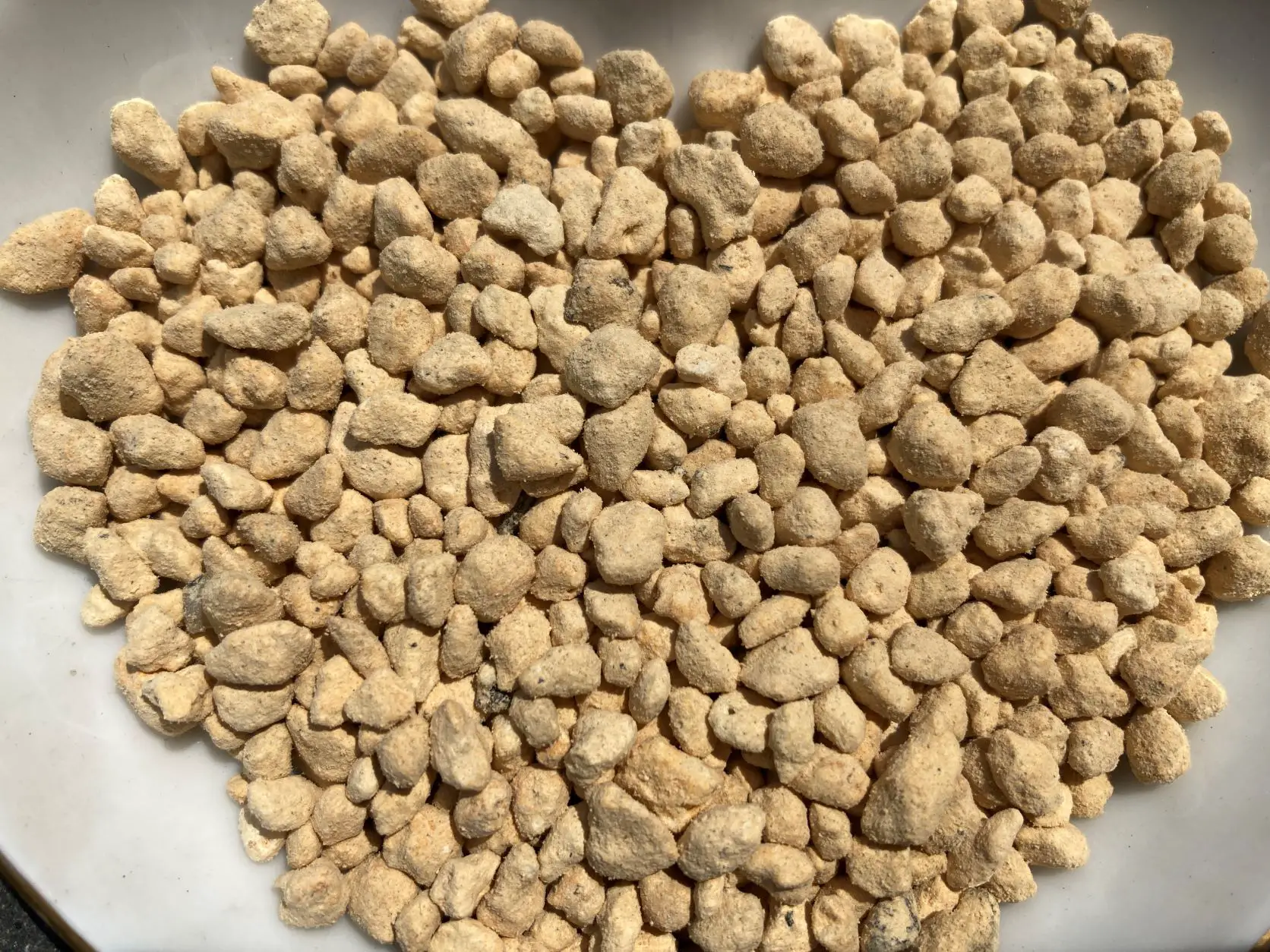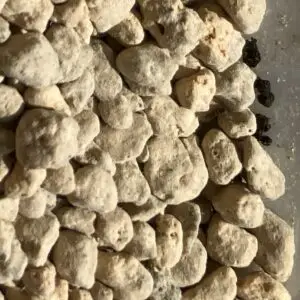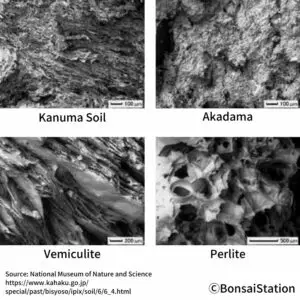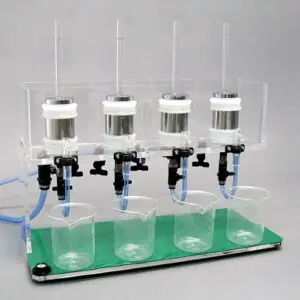What is Kanuma Soil?
What is Kanuma soil?
Volcanic pumice
Kanuma soil is a granular clay-like mineral used mainly as soil for bonsai trees. It is weathered volcanic pumice stone and not soil, which can be defined as a mixture of minerals and organic materials. Kanuma soil is small particles of eroded rock and does not contain organic materials.
Color
The color is pale yellow, which is close to white when dry as in the picture on the left. When it absorbs water, it changes color to brownish-yellow as in the picture on the right. And we can hear the clicking sound of water absorbed into the soil.
※Click to enlarge
Where is Kanuma soil from?
Kanuma soil is mined mainly in the vicinity of Kanuma City, Tochigi Prefecture, which is 90 miles north of Tokyo.
※Click to enlarge
Where is Kanuma soil found underground?
Kanuma soil is deposited in the lower layer of volcanic ash soil 6.5 to 10 feet below ground with a thickness of 3 feet on average. It is formed when Mt. Akagi erupted (red arrow on the right) with pumice about 30,000 to 40,000 years ago and was brought by the wind blowing towards the east.
※Click to enlarge
Kanuma soil is found in the vast area on the east side of Mt. Akagi, but its stratum is the thickest in Kanuma City area and thus its name.
What is the characteristic of Kanuma soil?
Naturally found in particles
Kanuma soil is somewhat rounded, irregular in shape particles with a size in the natural state in the range from 0.02 to 0.04 inches. It can be crushed by putting pressure, and the particle size becomes very fine from silt to clay depending on its degree.
Rich in silicon
Kanuma soil is very rich in silicon dioxide, which is good for plants under stress including bonsai trees.
(numbers in %)
| Kanuma | Akadama | |
| Silicon dioxide | 58.6 | 39.6 |
| Aluminum oxide | 17.1 | 24.6 |
| Ferric oxide | 1.93 | 9.0 |
| Magnesium oxide | 0.076 | 2.2 |
| Calcium oxide | 0.044 | 0.88 |
| Manganese oxide | 0.041 | 0.14 |
(Source: Tachikawa Heiwa Noen Co., Ltd.- link here)
Porous
The particles are porous. The soil mass has many pores with intra- and inter-particle gaps. In fact, we can see its porosity with naked eyes when we watch it very closely. When we touch it, it feels rough and coarse like pumice but softer, smoother and firmer.
※Click to enlarge
Observing through an electronic microscope, we see a lot of pores inside.
※Click to enlarge
With pores, the weight of Kanuma soil is lighter than other types of soil such as paddy soil.
Weight of soils (g/100ml)
| Small | Medium | Large | |
| Kanuma | 50.9 | 29.9 | 23.4 |
| Vermiculite | 19.3 | 12.9 | 13.4 |
| Perlite | 17.5 | 18.9 | NA |
| Paddy soil | 71.6 | 65.1 | 62.8 |
※Particle size- small: 1mm>; medium 1-3mm; large 3-6mm
(Source: Kojima, M. et., al. “Physicochemical properties of various materials for potting compost”. Japanese Journal of Soil Science and Plant Nutrition. 53巻・1号,p.53-56(1982-01)(link here)
Contains lots of water
Kanuma soil contains lots of water in its natural state.
Soil can be broken down into solid, liquid (water) and gas (air) components. Kanuma soil has comparatively less solid and more water as well as air, compared to lava soil (black volcanic soil mixed with organic materials), as shown in the table below.
Three phases of soils (%)
| Solid | Water | Air | |
| Kanuma | 13.2 | 55.1 | 31.7 |
| Lava soil | 24.4 | 48.6 | 27.0 |
| Paddy soil | 37.5 | 51.3 | 11.2 |
| Humus | 8.3 | 41.9 | 49.8 |
| Peat | 10.1 | 69.9 | 20.0 |
(Source: link here)
Moderately acidic
Kanuma soil is moderately acidic with pH of between 5.0 to 5.5, depending on the location of the mine, which is actually about the same level as Akadama.
It is said that Kanuma soil becomes more acidic like pH 4.0 when used as soil for plants but as far as I know, there is no research supporting this theory.
What is Kanuma soil good for?
Kanuma soil is best for bonsai soil, especially acid-loving species such as azalea, due to good water retention, drainage, and aeration as well as richness in silicon and acidity.
Kanuma soil has all the qualities that Bonsai soil requires;
- good water retention
- good drainage and
- good aeration.
It also has the following qualities;
4. rich in silicon
5. higher acidity.
Good water retention
As an experiment, botanical scientists examined Kanuma soil for its water retention and drainage (source: link here).
How they examined water retention
They put Kanuma and other soil samples separately in stainless bottles that can contain 100ml of water. They then put the bottom of the bottles 0.4 inches in the water. As the bottom rid is not tightly sealed, water was permeated into the soil through capillary saturation. After that, they weighed how much water each soil absorbed.
What they found
Here is what they found. Water retention of Kanuma soil is just slightly below lava soil, which is known to have a high water-holding capacity.
| Water retention (g/100ml) | |
| Kanuma | 49 |
| Akadama | 44 |
| Vermiculite | 46 |
| Lava soil | 54 |
(Source: Yoki ASANO, Mitsuru IKEDA, Miyo RYUNO. Development of a Simple Method for Measuring Physical Properties of Soil and Preparation of Clop Culture Soils Exhibiting Different Water Permeability. Journal of the Japan Society of Technology Education. 2017, Volume 59, Issue 3, Pages 229-235. Link here.)
Good drainage
How they examined drainage
For the drainage, they used special equipment, a “permeameter” as shown below in the picture, to measure water permeability. This equipment allows measuring saturated water permeability of the soil in the sampling tubes.
What they found
Here is what they found.
As shown in the table below, Kanuma soil has a very high drainage capability compared to lava soil, which holds water well but does not drain much. In fact, the lowest recommended level of drainage for gardening is 10ml/min, and Kanuma soil drains water at a much, much higher level.
| Drainage (ml/min) | |
| Kanuma | 403 |
| Akadama | 649 |
| Vermiculite | 601 |
| Lava soil | 9 |
(Source: Yoki ASANO, Mitsuru IKEDA, Miyo RYUNO. Development of a Simple Method for Measuring Physical Properties of Soil and Preparation of Clop Culture Soils Exhibiting Different Water Permeability. Journal of the Japan Society of Technology Education. 2017, Volume 59, Issue 3, Pages 229-235. Link here.)
Good aeration
Looking into a microscope, Kanuma soil is porous and has a structure in which many tube-like gaps are bundled together as in the picture on the right. There are different sizes of tubes, but they are lined up in parallel like pillars.
Air and water can pass through these tubes, allowing good aeration as well as drainage.
(Source: Yabashi, S. et., al. Studies on the Physical Properties of Horticultural Soils II. Chiba University. Vol 48 135-140 (1994) Link here.)
Rich in silicon
Kanuma soil is rich in silicon.
According to a scientific research article (link here), silicon is beneficial to plants, especially under stress conditions. In particular;
- Silicon alleviates the toxic effects caused by abiotic stresses, e.g., salt stress, drought, heavy metals, etc.;
- Silicon is a deterrent against herbivores; and
- Silicon ameliorates the vigor of plants and improves their resistance to exogenous stresses.
Higher acidity
Kanuma soil is good for bonsai species such as azalea which prefer acidic soil.













